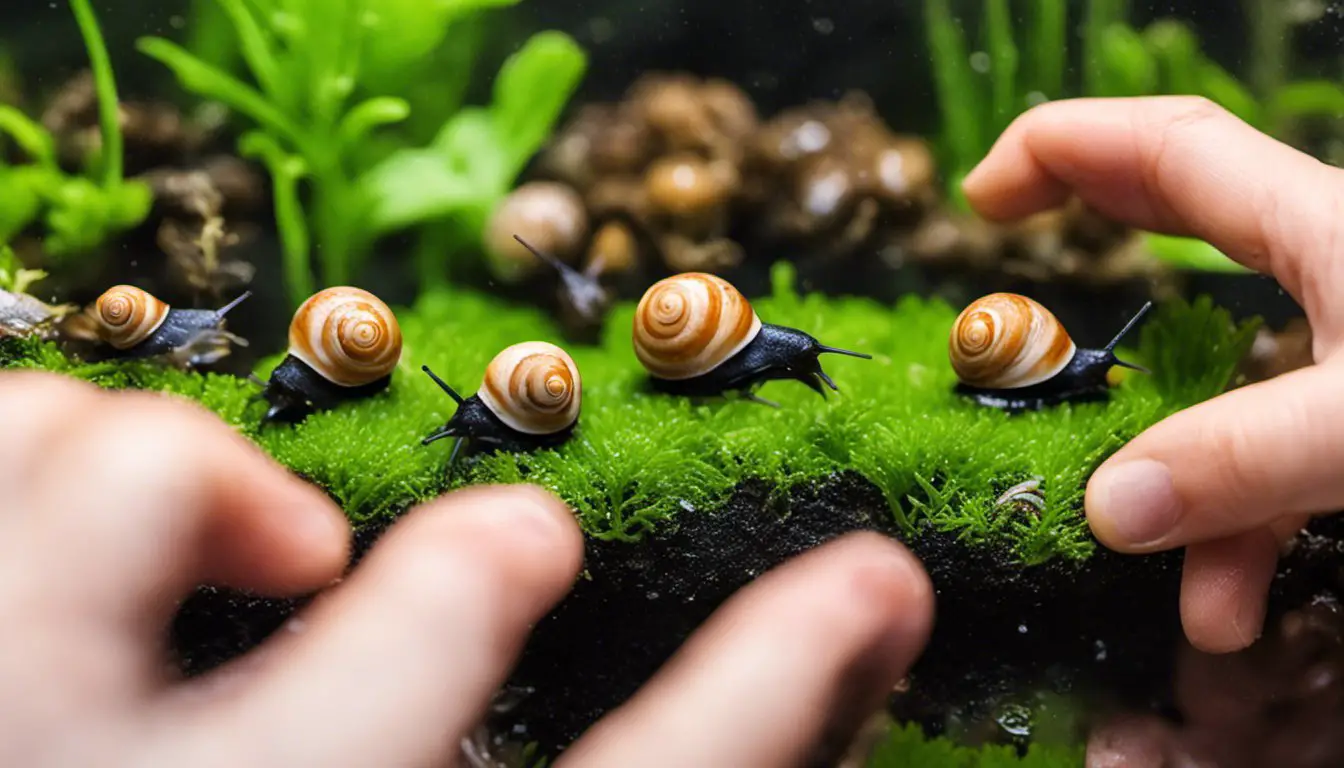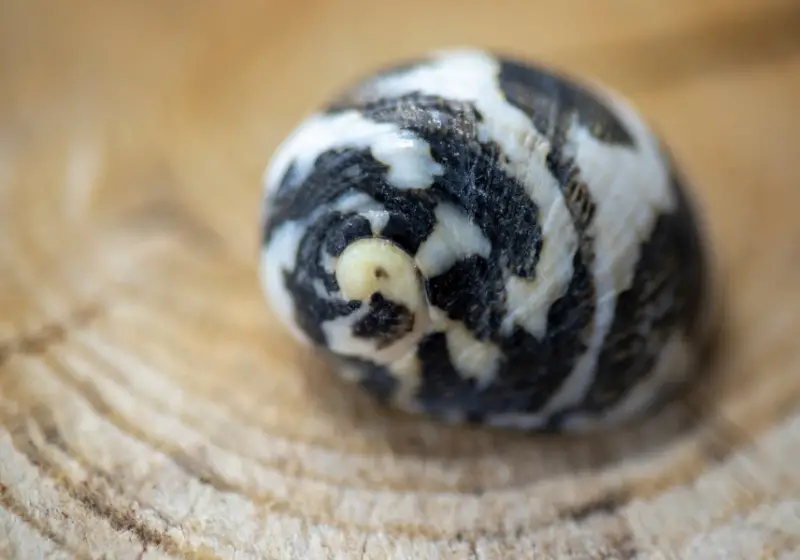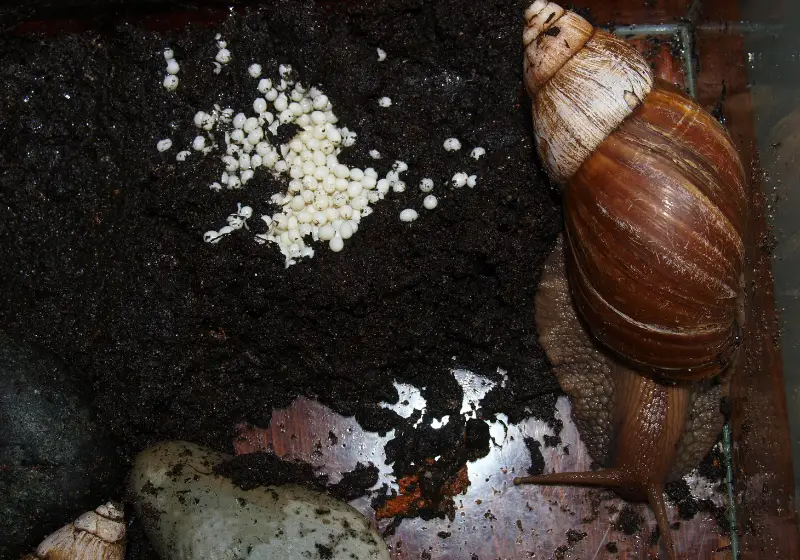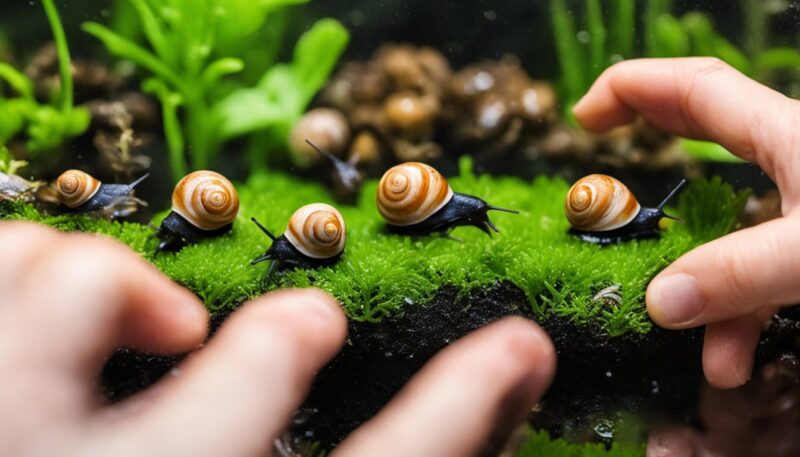Breeding Nerite Snails

Breeding nerite snails can be a fascinating and rewarding aspect of aquarium keeping. Known for their stunning patterns and colors, nerite snails are a popular choice for hobbyists wishing to add a vibrant touch to their freshwater tanks. Not only do they add visual interest, but they are also efficient tank cleaners, consuming algae and other waste that may accumulate.

When it comes to breeding nerite snails, though, success can be a bit challenging. These snails breed differently than many other aquarium snails, as they have distinct male and female genders and cannot reproduce independently.
Furthermore, their reproductive process involves laying their eggs in brackish water, which requires specific conditions in your aquarium. By carefully managing the environment and paying close attention to the needs of your snails, you might witness the miracle of their reproduction.
In this article, we will delve into the world of nerite snails and explore the factors that influence their breeding success. From understanding their anatomy to creating optimal living conditions, we aim to guide you through a successful breeding experience with your nerite snails. So, take a deep breath and start this fascinating journey together.
Contents
Table of Contents
Understanding Nerite Snails

Nerite snails belong to the Neritidae family and are a popular addition to freshwater aquariums due to their algae-eating habits and attractive appearance. This section will explore various species of nerite snails and their characteristics to help you better understand these fascinating creatures.
Species of Nerite Snails
There are several species of nerite snails, each with unique patterns and colors. Let’s take a closer look at some of the most common types:
- Zebra Nerite Snail: As the name suggests, the zebra Nerite snail features black and yellow stripes resembling a zebra pattern. They are great at consuming algae and keeping your tank clean.
- Olive Nerite Snail: The olive nerite snail has a smooth, dark green shell. Like other nerite snails, they also efficiently clean algae from aquarium surfaces.
- Horned Nerite Snail: Horned Nerite snails have black and yellow shells with small, horn-like projections. They add an interesting aesthetic to any aquarium and are just as good at managing algae as their relatives.
- Red Racer Nerite Snail: Known for their bright red shells, red racer nerite snails can be a striking addition to your tank. Along with their captivating appearance, they also help maintain a clean aquarium by consuming algae.
- Tiger Nerite Snail: With a shell resembling a tiger’s stripes, the tiger Nerite snail is another attractive species useful for controlling algae growth in your aquarium.
Understanding the different species of nerite snails can help you choose the best option for your tank. Their efficient algae-eating habits and distinct appearances make them great for maintaining a clean and beautiful aquatic environment.
Breeding Basics

Gender Differences
Determining the gender of your nerite snails is an important step before starting the breeding process. Unfortunately, it can be quite difficult to identify male and female nerite snails as they do not have distinct external features. However, you can try observing their shells’ size shape and behavior to make an educated guess.
Mating Behavior
When nerite snails are ready to breed, their mating behavior becomes more pronounced. You may notice them spending more time together, and the male might try to climb onto the female’s shell. While forcing the snails to breed is difficult, housing them together and providing adequate environmental conditions may encourage them to mate naturally.
Breeding Process
Once the nerite snails have mated, the female will lay her eggs. These eggs are usually laid above the water line in the aquarium, so it is important to provide a suitable space for them to do so. Unlike other common aquarium snails, nerite snails do not reproduce in freshwater aquaria.
Their eggs require brackish water to develop and hatch properly. Therefore, to raise baby nerite snails, you must set up a separate tank with the appropriate brackish water conditions.
In summary, breeding nerite snails requires the determination of their gender, observation of their mating behavior, and providing suitable conditions for their eggs to develop. Remember always to maintain a clean and healthy environment for your nerite snails to ensure their well-being.
Creating a Suitable Environment

Aquarium Selection
To breed nerite snails, you must set up the right habitat. Choose a suitable tank that provides enough space for the snails and their offspring. For every 1 inch of nerite snail, allocate 5 gallons of water in the aquarium. A brackish water tank is necessary for breeding, as nerite snails can only breed in brackish water conditions.
Ensure you have hard substrates in the tank, such as a mix of calcium sand or rocks. This will give the snails secure surfaces to lay their eggs and facilitate their natural behavior.
Water Parameters Control
Maintaining the water parameters within the acceptable ranges for nerite snails is crucial. For breeding, you should aim to achieve a specific gravity of 1.005-1.010, as this creates suitable brackish water conditions. The temperature range should be between 68-77°F (20-25°C) and a pH level of 7.5-8.5.
Keep an eye on water hardness, ideally maintaining a general hardness (GH) within the range of 5-12 dGH. Consistently monitor the total dissolved solids (TDS) in your brackish water tank to ensure a stable environment for the snails.
Create a checklist for maintaining the water parameters:
- Specific gravity: 1.005-1.010
- Water temperature: 68-77°F (20-25°C)
- pH level: 7.5-8.5
- General hardness (GH): 5-12 dGH
Setting up your aquarium with the right conditions and paying attention to water parameters will create a comfortable environment for your nerite snails to breed in. This will increase the chances of a successful breeding process, ensuring a thriving population of nerite snails in your tank.
Diet and Feeding

Nerite snails are known for their impressive appetite for algae, which makes them excellent additions to your aquarium. As a dedicated algae-eater, they consume various types of algae, such as diatoms and green algae, making them a valuable asset for maintaining a healthy aquatic environment.
While algae forms the main staple of their diet, providing additional food sources to ensure optimal health for your nerite snails is essential. Blanched vegetables like cucumber, zucchini, and spinach are excellent options to introduce into your tank. These vegetable pieces can be anchored to the aquarium using a vegetable clip or weight, making it easier for the snails to access the food.
Since nerite snails are herbivores, offering them food designed for their specific dietary needs is crucial. One such option is to provide them with vegetarian sinking pellets or herbivore wafers catering to their nutritional requirements. Consider feeding them commercial herbivore food and providing a balanced diet that promotes a healthy shell and overall well-being.
Feeding Tips:
- Offer a variety of blanched vegetables for better nutrition.
- Remove any uneaten food within 24 hours to prevent water quality issues.
- Keep an eye on your tank’s algae levels, as nerite snails may consume it rapidly.
- Monitor your snails’ health, and adjust their diet as needed accordingly.
By providing a diverse diet encompassing algae, blanched vegetables, and suitable commercial food, you can ensure that your nerite snails stay healthy and contribute to a cleaner aquarium environment.
Egg-Laying and Care

Egg Laying Process
Nerite snails are known for their beneficial algae-eating habits, but breeding them can be challenging. Unlike other snail species, nerite snails require specific conditions to lay their eggs successfully. Females will lay small white eggs on hard surfaces like rocks, glass, and decorations within your aquarium.
It’s important to note that these eggs will only hatch in brackish water, not in typical freshwater tanks. To increase the likelihood of successful breeding, ensure your aquarium has adequate hiding spaces and a stable environment.
Caring for Eggs
Once the female nerite snail has laid her eggs, properly caring for them is essential. Here are a few pointers to help you care for the eggs:
- Water parameters: Maintain the water conditions within the appropriate range for nerite snails: pH levels between 7.0-8.5 and a temperature of 71-79°F (22-26°C).
- Brackish water: As mentioned earlier, the eggs require brackish water to hatch. To create this type of environment, you’ll need to gradually increase the salinity of the water, typically by adding a marine salt mix. Monitoring and maintaining the salinity levels within a specific gravity range of 1.005-1.010 is crucial.
- Gentle water flow: A gentle water flow in the area where the eggs are can help ensure they receive the oxygen necessary for proper development.
- Tank cleanliness: Keeping the tank clean is vital for the overall health of all inhabitants, including the eggs and the larvae that will hatch from them. Continue your regular maintenance schedule, performing water changes and cleaning the substrates.
By following these guidelines and closely monitoring the eggs, you increase the chances that your Nerite snails’ eggs will hatch into healthy larvae, eventually growing into adult snails that keep your aquarium clean and algae-free.
Tank Maintenance

Cleaning and Water Changes
Proper tank maintenance is essential for the well-being of your nerite snails. Regular cleaning and water changes help maintain a healthy environment for the snails and prevent build-up of harmful substances. Start by removing any debris, uneaten food, or dead plant matter from the aquarium using a net or gravel vacuum. This will help keep the tank clean and ensure a pleasant appearance.
Perform water changes every two weeks or as needed to maintain ideal water quality. Replacing about 25%-30% of the tank water during each change is crucial. Before adding fresh water, ensure it is treated with a water conditioner that neutralizes chlorine and heavy metals. Monitor the water quality regularly, paying close attention to the ammonia, nitrite, and nitrate levels.
A quality filter is necessary in your tank to aid in water circulation and remove unwanted debris. Ensure you clean the filter media monthly or as specified by the manufacturer to maintain its efficiency.
Lighting and Temperature Control
The lighting and temperature of your aquarium play a significant role in your nerite snails’ health and comfort. Maintaining proper lighting and temperature conditions will benefit your snails and contribute to a thriving aquatic environment.
Nerite snails are low-light creatures, so indirect lighting or diffused sunlight is ideal for their tanks. Too much direct sunlight can lead to excessive algae growth, harming the aquarium’s health. Ensure you keep a consistent day and night cycle by turning off the lights for about 8-12 hours each day.
Pay attention to the water temperature in your tank, as nerite snails do best in stable conditions. The ideal temperature range for these snails is between 72°F and 78°F (22°C – 26°C). Utilize an aquarium heater and a thermometer to achieve and monitor the optimal temperature range.
Regularly check the functioning of these devices to prevent any fluctuations or equipment failure from causing temperature stress to your snails.
Has he Bred Nerite Snails In Fresh Water? Watch this
Preventing Common Issues
Dealing with Algae Growth
Algae growth is common in nerite snails’ tanks, as they thrive on algae. Regularly monitor and maintain your aquarium’s water parameters to prevent excessive algae growth. Keep the nitrate levels in check by conducting periodic water changes and using nitrate-absorbing filter media.
Introduce live plants into the aquarium to help compete with algae for nutrients. In addition, controlling the lighting in your aquarium can help limit algae growth. Limit the exposure to sunlight and use artificial lighting on a timer to ensure consistent light cycles. 8 to 10 hours of light daily is sufficient for a well-maintained aquarium.
Controlling Aggressive Behavior
While nerite snails are generally peaceful, some may exhibit aggressive behaviors towards tank mates, especially when competing for food or resources. To avoid confrontation and potential harm, here are some steps you can take:
- Provide adequate hiding spots in the aquarium, such as plants, rocks, or other decor, where snails can retreat when feeling threatened.
- Ensure the aquarium has enough space for all occupants, allowing each creature to establish its territory.
- Distribute food evenly across the aquarium when feeding, ensuring all snails have equal feeding opportunities and reducing competition.
- Monitor your aquarium regularly to identify signs of aggressive behavior early on and address the issue before it escalates.
By following these guidelines, you can prevent common issues associated with breeding nerite snails, ensuring a healthy and harmonious environment for them to thrive.
Common Species of Nerite Snails

When exploring the world of nerite snails, you will come across various fascinating species. Each has unique characteristics and can contribute to maintaining the balance in your aquarium. This section will focus on four popular types: zebra nerite snails, tiger nerite snails, olive nerite snails, and horned nerite snails.
Zebra nerite snails (Neritina natalensis Zebra) are distinctive due to their striking black and yellow striped pattern, resembling a zebra’s skin. They are prevalent in freshwater aquariums because of their ability to remove algae efficiently. With a manageable size of around 1 inch, they make a great addition to a tank with other peaceful species.
Tiger nerite snails (Neritina turrita), similar to zebra nerites, also sport a black and yellow pattern, although it appears more as spots than stripes. This species is a little larger, growing up to 1.2 inches. They are renowned for their algae-eating capabilities, making them an excellent addition to a community tank.
Unlike the previous two, Olive nerite snails (Neritina reclivata) have a more muted appearance. They display an olive-green shell without any distinct patterns. Their smaller size (about 0.5 inches) and efficient algae-eating habits make them well-suited for tanks with low to moderate lighting. Not only do they help keep the glass clean, but they also add a subtle touch of color to your aquarium.
Horned nerite snails (Neritina Clithon corona) stand out due to their tiny horns protruding from their shells, giving them a unique appearance. They come in various colors, from black to yellow, and can grow up to 1 inch. Like other nerite species, they are efficient at controlling algae in the tank, and their interesting appearance makes them a popular choice among aquarists.
In summary, zebra, tiger, olive, and horned nerite snails bring something unique to your aquarium while providing essential algae control. Understanding their characteristics will help you select the best species to keep your tank clean, healthy, and visually appealing.
Successfully Breeding Nerite Snails

To achieve successful breeding of nerite snails, you’ll need to be diligent in preparing a suitable environment for them. Start by setting up a breeding tank with the appropriate water conditions, including brackish water with a salinity level of 1.005-1.010 and proper substrate, such as a mix of calcium sand for a saltwater environment.
Once your breeding tank is ready, introduce male and female snails, being aware that identifying their gender can be challenging. Observe their behavior closely to ensure that they are mating. After laying eggs, providing a nurturing environment for the developing snails is essential. A nursing tank can effectively separate the young from the adult snails while they grow.
As the juveniles develop, monitor their progress and adjust the water conditions accordingly. Proper care will help ensure that they grow into healthy adults. Remember, breeding nerite snails can be a complex process, but with careful planning and attention, you can successfully raise these fascinating creatures in your aquarium.
By following these guidelines, you’ll set yourself on a path toward becoming a confident and knowledgeable nerite snail breeder. Armed with this clear and neutral information, you can now embark on your journey to raise these unique invertebrates in your aquarium. Good luck!
Frequently Asked Questions
What is the breeding process for nerite snails?
Breeding nerite snails involves several steps. First, males and females come together and mate. After copulation, the female lays her eggs. These eggs are typically left on surfaces within your tank, such as driftwood or aquarium glass.
However, it is important to note that nerite snails are known to have difficulty reproducing in freshwater environments, as their offspring require saltwater or brackish water to thrive. Once the larvae hatch, they must transition to a freshwater environment to grow and mature into adult snails.
Do nerite snails need brackish water to breed?
Yes, nerite snails need brackish water to breed successfully. Although nerite snails can survive and thrive in freshwater tanks, their larvae require brackish water to develop and grow properly. If you plan on breeding nerite snails, you must provide a separate brackish water tank for their larvae to ensure their survival and healthy growth.
What is the growth rate of baby nerite snails?
The growth rate of baby nerite snails depends on various factors, such as water quality, temperature, and food availability. Under optimal conditions, baby nerite snails can grow quite fast. However, it is challenging to determine an exact growth rate due to the difficulty of replicating these conditions in a home aquarium. Baby Nerite snails can take several months to a year to grow into adulthood.
How can I encourage nerite snail breeding?
To increase your chances of successful nerite snail breeding, you should maintain a comfortable environment for the snails, including proper water parameters like a temperature range of 20–26 °C (60–79 °F), a pH range of 6.0–8.0, and a TDS range of 60–200 PPM (source). Additionally, keep the lighting levels low, as nerite snails prefer darker environments for breeding (source). Finally, provide plenty of hiding spots and a dark substrate to give them a sense of security and encourage reproduction.
Will a pair of Nerite snails reproduce in my tank?
It’s unlikely that a pair of Nerite snails will reproduce in your freshwater tank. This is because their eggs and larvae require brackish water conditions for their development and survival. While you may see nerite snails laying eggs in a freshwater tank, the offspring will likely not survive without the proper brackish water environment.
How frequently do Nerite snails lay eggs?
Nerite snails can lay eggs quite frequently, but the exact frequency can vary depending on water conditions, food availability, and stress levels. It’s important to note that even though they lay eggs in freshwater environments, the larvae will not survive without brackish water conditions. Hence, they will not overpopulate your tank (source).




![Do Snails Need Water? [Complete Guide]](https://allourcreatures.com/wp-content/uploads/2021/11/do-snails-need-water-768x513.jpg)

